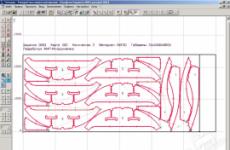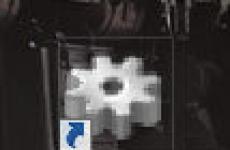Air permeability of building materials. Air permeability of enclosing structures Separation of layers of a steampower
In the main mass are porous bodies. The sizes and structure of the pores in different materials are non-etinak, so the air permeability of materials, depending on the pressure difference, is manifested differently.
Fig.11 shows a high-quality picture of the dependence of air permeability G. from pressure difference ΔР. For building materials, given by K.F. Fokin.
Fig.11. The effect of material porosity on its air permeability.1 - materials with uniform porosity (type foam concrete); 2 - materials with pores of various sizes (type of frustration); 3 - low-load-permeable materials (type of wood, cement solutions), 4 - wet materials.
Straight plot from 0 to point but On Curve 1 indicates a laminar movement of air in terms of material with a uniform porosity at small pressure difference values. Above this point in the curvilinear site there is a turbulent movement. In materials with different sizes of pores, air traffic turbulently even at a low pressure difference, which can be seen from the curvature of the line 2. In low-breeded materials, on the contrary, the movement of air on the peres of laminar and at quite large pressure differences, therefore addiction G. from ΔР. Linear with any pressure difference (line 3). In wet materials (curve 4) at small ΔР.less than a certain minimum pressure difference Δp minThe breathability is absent, and only with exceeding this value, when the pressure difference will be sufficient to overcome the forces of the surface tension of water contained in the pores of the material, air movement occurs. The higher the moisture content of the material, the greater the value Δp min.
When laminar air movement in the pores of the material is valid dependency
where G is the air permeability of the fencing or layer of material, kg / (m. 2. h);
i. - coefficient of air permeability of material, kg / (m. PA. H);
δ - Material layer thickness, m.
The coefficient of air permeability of the material The coefficient of thermal conductivity is similar and shows the degree of air permeability of the material, numerically equal to the flow of air into kg, passing through 1 m 2 of the area, perpendicular to the flow direction, in the pressure gradient equal to 1 pa / m.
The magnitudes of the air permeability coefficient for various building materials differ significantly from each other.
For example, for mineral wool I ≈ 0.044 kg / (m. PA. H), for non-autoclaus foam concrete I ≈ 5.3.10 - 4 kg / (m. P. H), for solid concrete I ≈ 5.1.10 - 6 kg / (m. P. H),
When turbulent air movement in the formula (2.60) should be replaced ΔР.on the ΔP N.. In this case, the indicator of the degree n. It changes in the range of 0.5 - 1. However, in practice of formula (2.60), it is also used for the turbulent mode of air flow in the pores of the material.
In modern regulatory literature, the concept of breathability coefficient is not applied. Materials and designs are characterized resistance to breathing R and,kg / (m. h). During the difference in pressures on different sides? P o \u003d 10 Pa, which, with a laminar air movement, is located by the formula:
where G is the air permeability of the layer of material or design, kg / (m 2. h).
Resistance to air permeation of fences in its dimension does not contain the dimension of air transfer potential - pressure. This provision arose due to the fact that in regulatory documents dividing the actual pressure difference? P on the regulatory value of pressures? P O \u003d 10 Pa, resistance to air permeation is given to the pressure difference? P O \u003d 10 Pa.
The values \u200b\u200bare given resistance air permeal For layers of some materials and structures.
For windows, in the looser to which air movement occurs during mixed mode, resistance to air permeation , kg / (m. h) is determined from the expression:
Questions for self-control
1. What is the air permeability of material and fence?
2. What is air permeal?
3. What is infiltration?
4. What is exofiltration?
5. What is the quantitative characteristic of the air permeal process called breathability?
6. Through what two types of looseness is air filtration in fences?
7. What three types of filtering exist, according to the terminology of R.E. Brillig?
8. What is the potential of air permeation?
9. What two nature form pressure difference on opposite sides of the fence?
10. What is the coefficient of air permeability of the material?
11. What is the resistance to the air permeation of the enclosing structure?
12. Write the formula to determine the resistance to air permeal with a laminar air movement through the pores of the design materials.
13. Write the formula to determine the resistance to the air permeation window.
Parry permeability table - This is a complete summary table with vapor permeability data of all possible materials used in construction. The word "vapor permeability" itself means the ability of layers of building material or skip, or to delay the water vapors due to different pressure values \u200b\u200bon both sides of the material at the same atmospheric pressure indicator. This ability is also called the coefficient of resistance and is determined by special values.
The higher the record permeability, the more the wall can accommodate moisture, which means that the material is low frost resistance.
Parry permeability table It is indicated by the following indicators:
- Thermal conductivity is a kind, indicator of the energy transfer of heat from more heated particles to less heated particles. Therefore, an equilibrium in temperature modes is established. If high thermal conductivity is installed in the apartment, this is the most comfortable conditions.
- Heat capacity. With the help of it, you can calculate the amount of heat supplied and the heat contained in the room. Be sure to bring it to the real volume. Due to this, you can fix the temperature change.
- Thermal assimilation is a fencing structural alignment at temperature fluctuations. In other words, thermal assimilation is the degree of absorption of moisture walls.
- Thermal stability is the ability to protect the designs from sharp fluctuations in thermal flows.
Fully all comfort in the room will depend on these thermal conditions, which is why the construction is so necessary parry permeability tableSince it helps effectively compare the variety of vapor permeability types.
On the one hand, vapor permeability affects the microclimate, and on the other, it destroys materials from which houses are built. In such cases, it is recommended to set a layer of vaporizolation from the outside of the house. After that, the insulation will not skip steam.
Parosolation is materials that apply from the negative effects of air vapor in order to protect the insulation.
There are three classes of vaporizolation. They differ in mechanical strength and vapor permeability resistance. The first class of vaporizolation is stringent materials, which are based on foil. The second class includes polypropylene or polyethylene materials. And the third class make up soft materials.
Parry permeability table of materials.
Parry permeability table Materials - These are building standards for international and domestic standards of vapor permeability of building materials.
|
Material |
Parry permeability coefficient, mg / (m * h * pa) |
|---|---|
|
Aluminum |
|
|
Arbolit, 300 kg / m3 |
|
|
Arbolit, 600 kg / m3 |
|
|
Arbolit, 800 kg / m3 |
|
|
Asphalt concrete |
|
|
Foamed synthetic rubber |
|
|
Plasterboard |
|
|
Granite, Gneis, Basalt |
|
|
Chipboard and dvp, 1000-800 kg / m3 |
|
|
Chipboard and dvp, 200 kg / m3 |
|
|
Chipboard and dvp, 400 kg / m3 |
|
|
Chipboard and dvp, 600 kg / m3 |
|
|
Oak along the fibers |
|
|
Oak across fibers |
|
|
Reinforced concrete |
|
|
Limestone, 1400 kg / m3 |
|
|
Limestone, 1600 kg / m3 |
|
|
Limestone, 1800 kg / m3 |
|
|
Limestone, 2000 kg / m3 |
|
|
Keramzit (bulk, i.e. gravel), 200 kg / m3 |
0.26; 0.27 (SP) |
|
Keramzit (bulk, i.e. gravel), 250 kg / m3 |
|
|
Keramzit (bulk, i.e. gravel), 300 kg / m3 |
|
|
Keramzit (bulk, i.e. gravel), 350 kg / m3 |
|
|
Ceramizite (bulk, i.e. gravel), 400 kg / m3 |
|
|
Keramzit (bulk, i.e. gravel), 450 kg / m3 |
|
|
Keramzit (bulk, i.e. gravel), 500 kg / m3 |
|
|
Keramzit (bulk, i.e. gravel), 600 kg / m3 |
|
|
Keramzit (bulk, i.e. gravel), 800 kg / m3 |
|
|
Ceramzitobeton, density 1000 kg / m3 |
|
|
Ceramzitobetone, 1800 kg / m3 density |
|
|
Ceramzitobeton, density 500 kg / m3 |
|
|
Ceramzitobeton, density of 800 kg / m3 |
|
|
Ceramographic |
|
|
Brick clay, masonry |
|
|
Brick ceramic hollow (1000 kg / m3 gross) |
|
|
Brick ceramic hollow (1400 kg / m3 gross) |
|
|
Brick, silicate, masonry |
|
|
Romatic ceramic block (warm ceramics) |
|
|
Linoleum (PVC, i.e. unpretentious) |
|
|
Minvata, Stone, 140-175 kg / m3 |
|
|
Minvata, Stone, 180 kg / m3 |
|
|
Minvata, Stone, 25-50 kg / m3 |
|
|
Minvata, Stone, 40-60 kg / m3 |
|
|
Minvata, Glass, 17-15 kg / m3 |
|
|
Minvat, Glass, 20 kg / m3 |
|
|
Minvata, Glass, 35-30 kg / m3 |
|
|
Minvata, Glass, 60-45 kg / m3 |
|
|
Minvata, Glass, 85-75 kg / m3 |
|
|
OSP (OSB-3, OSB-4) |
|
|
Foam concrete and aerated concrete, density 1000 kg / m3 |
|
|
Foam concrete and aerated concrete, 400 kg / m3 density |
|
|
Foam concrete and aerated concrete, 600 kg / m3 density |
|
|
Foam concrete and aerated concrete, density of 800 kg / m3 |
|
|
Polystyrene foam (foam), stove, density from 10 to 38 kg / m3 |
|
|
Polystyrene foam extruded (EPPS, XPS) |
0.005 (SP); 0,013; 0.004. |
|
Polystyrene foam, stove |
|
|
Polyurethane foam, 32 kg / m3 density |
|
|
Polyurene foam, 40 kg / m3 density |
|
|
Polyurethan, density 60 kg / m3 |
|
|
Polyurethan, density 80 kg / m3 |
|
|
Foam glass block |
0 (rare 0.02) |
|
Foam glass bulk, density 200 kg / m3 |
|
|
Foam glass bulk, density 400 kg / m3 |
|
|
Tile (tile) Ceramic glazed |
|
|
Clinker tile |
low; 0.018 |
|
Plate from plaster (plaster), 1100 kg / m3 |
|
|
Plates of plaster (plaster), 1350 kg / m3 |
|
|
Fibrolite and arbolit plates, 400 kg / m3 |
|
|
Fibrolite and arbolit plates, 500-450 kg / m3 |
|
|
Polyurea |
|
|
Polyurethane mastic |
|
|
Polyethylene |
|
|
Spring-sand-sand with lime (or plaster) |
|
|
Cement-sand-limestone solution (or plaster) |
|
|
Cement-sandy (or plaster) |
|
|
Ruberoid, Pergamine |
|
|
Pine, spruce along the fibers |
|
|
Pine, fir across fibers |
|
|
Plywood glued |
|
|
Equata pulp |
Parry permeability of materials Table is the construction rate of domestic and, of course, international standards. In general, vapor permeability is a certain ability of the plated layers to actively pass water pairs due to different pressure results with a homogeneous atmospheric index from two sides of the element.
The considered ability to skip, as well as to delay the water vapors is characterized by special values \u200b\u200bweighing the name of the coefficient of resistance and vapor permeability.
At the moment, it is better to emphasize your own attention to international ISO standards. It is they who determine the qualitative vapor permeability of dry and wet elements.
A large number of people are adherents that breathing is a good sign. However, it is not. Breathable elements are those structures that are passing both air and pairs. Increased vapor permeability, clamzits, foam concrete and trees have increased vapor permeability. In some cases, bricks also have these indicators.
If the wall is endowed with high vapor permeability, this does not mean that it becomes easy to breathe. A large amount of moisture is recruited in the room, respectively, low frost resistance appears. Going through the walls, the pairs turn into ordinary water.
Most manufacturers in the calculations of the index under consideration do not take into account important factors, that is, the chitryat. According to them, each material is carefully succeeded. The references increase the thermal conductivity five times, therefore, in the apartment or in other rooms it will be cold enough.
The most terrible moment is the fall in the night temperature modes leading to the displacement of the dew point in the wall outlook and the further freezing of condensate. Subsequently, the formed frozen water begins to actively destroy the surfaces.

Indicators
Parput of materials The table indicates existing indicators:
- , which is the energy type of heat transfer from strongly heated particles to less heated. Thus, equilibrium in temperature modes appears and appears. With a high apartment thermal conductivity, live can be most comfortable as possible;
- Thermal capacity calculates the amount of heat supplied and contained. Its mandatory must be taken to the real volume. This is how the temperature change is considered;
- The thermal assimilation is a fencing structural alignment in temperature fluctuations, that is, the degree of absorption of moisture with the wall surfaces;
- Thermal stability is a property that enhances the structures from sharp thermal vibrational flows. Absolutely all full comfort in the room depends on common thermal conditions. Thermal stability and capacity can be active in cases where the layers are performed from materials with increased thermal learning. Sustainability provides normalized status designs.

Parry permeability mechanisms
The moisture located in the atmosphere, under the reduced level of relative humidity, is actively transported through the available pores in the building components. They acquire appearance similar to individual water vapor molecules.
In cases where the humidity begins to rise, the pores in the materials are filled with liquids, directing the mechanisms for downloading in capillary sics. Parry permeability begins to increase, lowering the coefficients of resistance, with an increase in humidity in the construction material.

For internal structures in the already unleated buildings, indicators of dry-type vapor permeability are used. In places where heating is variable or temporary use of wet types of building materials intended for an outdoor design of structures.
Parry permeability of materials, the table helps effectively compare the variety of vapor permeability types.
Equipment
In order to correctly determine vapor permeability indicators, experts use specialized research equipment:
- Glass cups or vessels for research;
- Unique means necessary for measuring thickness processes with a high level of accuracy;
- Analytical type scales with weighing error.

In the process of construction, any material must first be assessed by its operational and technical characteristics. Solving the task to build a "breathable" house, which is the most characteristic of buildings from brick or wood, or vice versa to achieve maximum vapor-permeal resistance, you need to know and be able to operate with tabular constants to obtain calculated indicators of the vapor permeability of building materials.
What is the vapor permeability of materials
- the ability to skip or delay water vapor as a result of the difference in the partial pressure of water vapor on both sides of the material with the same atmospheric pressure. Parry permeability is characterized by a vapor permeability ratio or resistance of vapor permeability and is normalized by SNIP II-3-79 (1998) "Construction Heat Engineering", namely, the head of 6 "Resistance to ParProoting Fencing Constructions"
Parry permeability table is represented in Sniped II-3-79 (1998) "Construction Heat Engineering", Annex 3 "Heat Engineering Indicators of Construction Materials". Indicators of vapor permeability and thermal conductivity of the most common materials used for construction and insulation of buildings are presented later in the table.
Material | Density, kg / m3 | Thermal conductivity, W / (m * c) | Parp permeability, mg / (m * h * pa) |
Aluminum | |||
Asphalt concrete | |||
Plasterboard | |||
Chipboard, osp | |||
Oak along the fibers | |||
Oak across fibers | |||
Reinforced concrete | |||
Cardboard facing | |||
Ceramzit | |||
Ceramzit | |||
Ceramzitobeton | |||
Ceramzitobeton | |||
Brick ceramic hollow (gross1000) | |||
Brick ceramic hollow (gross1400) | |||
Red clay brick | |||
Brick, silicate | |||
Linoleum | |||
Minvata. | |||
Minvata. | |||
Foam concrete | |||
Foam concrete | |||
PVC foam | |||
Polystyrene foam | |||
Polystyrene foam | |||
Polystyrene foam | |||
Polystyrene foam echrouded | |||
Polyurene Foolder | |||
Polyurene Foolder | |||
Polyurene Foolder | |||
Polyurene Foolder | |||
Foamglo | |||
Foamglo | |||
Sand | |||
Polyurea | |||
Polyurethane mastic | |||
Polyethylene | |||
Ruberoid, Pergamine | |||
Pine, spruce along the fibers | |||
Pine, fir across fibers | |||
Plywood glued |
Air permeability - This is the ability of materials to skip air. A prerequisite for passing air through the material is the presence of air pressure drop (D R) on both sides of the sample of the material. The higher the pressure difference value, the more intense the process of passing the air through the material. For low air flow rates through materials, the dependence of the air movement rate from the pressure drop value is linear in nature and is expressed by the D'Arci equation:
This dependence occurs at low values \u200b\u200bor with a dense textile structure structure. With an increase in air movement speed through materials, a deviation may be observed from a linear character of the dependence of the pressure from the pressure drop. In this regard, for household materials intended for the manufacture of clothing, in accordance with the standard (GOST 12088-77), air permeability is estimated at a pressure drop \u003d 49 Pa (5 mm of water), which corresponds to the conditions of operation of clothing in the climatic conditions of the middle strip of Russia where the wind speed is no more than 8-10 m / s.
Generally accepted air permeability characteristic is ferrium coefficient , dm 3 / (m 2 ∙ s):
 , (58)
, (58)
where - the volume of air, DM 3, passing through the working part of the sample of the material, the area of \u200b\u200bwhich, m 2, in the time equal to 1 s, with pressure drop.
When using M 3 as a unit of measuring the volume of air passing through the material sample, the resulting value of the air permeability coefficient (m 3 / (m 2 × C)) is numerically equal to the speed of air movement through the material (m / s).
The air permeability of modern materials varies widely - from 3.5 to 1500 dm 3 / (m 2 ∙ c) ( table. eight).
Table 8 Grouping of fabrics by breathability
(according to N. A. Arkhangelsky)
| Group of fabrics | Fabrics | General characteristics of air permeability group of fabrics | , dm 3 / (m 2 ∙ s), at \u003d 49 pa |
| I. | Dry Drap and Cloth, Cotton Fabric, Diagonal, Facial Cloth | Very small | Less than 50. |
| II. | Costume wool fabrics, cloth, drape | Malaya | 50–135 |
| III | Lower, dresses, demi-season, light suit fabrics | Below average | 135–375 |
| IV | Lightweight and dresses | Average | 375–1000 |
| V. | The lightest dresses with large through pores | Increased | 1000–1500 |
| VI | Marley, Mesh, Kanva, Openwork and Fileny Knitwear | High | More than 1500. |
The air flow passes through the pores of the textile material, so air permeability indicators depend on the structural characteristics of the material that determine its porosity, the number and dimensions of the pore. Materials from thin highly twisted threads have a large number of through pores and, accordingly, large air permeability compared with materials made of thick fluffy threads, in which the pores are partially closed with protruding fibers or thread loops.
The most important structural characteristics of textile canvases that have through pores, which are mainly determined by their breathability, are the thickness of the canvas, the amount of through porosity and the characteristic size of the diameter (diameter) of through pores. Determine the values \u200b\u200bof air flow rate through material with different pressure drops, you can use the mathematical model proposed by A.V. Kulichenko, which has the view
 , (59)
, (59)
where - air viscosity, MPa ∙ C; - diameter of through pore, m;
- through porosity; - material thickness, m.
In cases where the materials do not have through pores, their breathability is determined by the total porosity, pore size and thickness thickness. Thus, for non-woven materials based on fibrous canvas, the dependence of the coefficient of breathability from their structure is expressed experimentally obtained by A. V. Kulichenko with equations having a general view
 , (60)
, (60)
where - filling the nonwoven material with fibers; L.- material thickness; - The parameter associated with the geometric characteristics of the fibers.
Among the most important factors on which the air permeability of materials depends, their humidity relates. The value of this factor is higher than the greater density of the material and the higher the hygroscopic properties of the fibers from which it is manufactured. Thus, according to B. A. Buzova, with 100% humidity of woolen cloth fabrics, breathability compared to air-dry state decreases by 2-3 times. Reducing the air permeability of materials for moisture is associated with the swelling of the fibers and the appearance of micro and maccapillary moisture, which causes a sharp reduction in the number and sizes of pores and, ultimately, leads to an increase in the aerodynamic resistance of the material and, accordingly, to a decrease in air permeability coefficient.
The deformation of textile materials causes significant changes in their structure (in particular, porosity) is disturbed), which leads to a change in air permeability. Studies conducted in the Ivanovo State Textile Academy of Prof.V. V. Veselov, showed that with asymmetric two-axis tension of the tissue, there was first a slight decrease in air permeability, and then its increase to 60% of the initial value. This is due to the complex nature of the restructuring of the structure of the material, which is associated with the stretching and compression of the filaments of the base and duck.
The most significant effect of stretching deformation on air permeability is manifested in knitted canvases. Unlike tissues, knitted canvases have higher extensibility, which is associated with greater mobility of their structure, sensitive even to low values \u200b\u200bof the stretching efforts applied to them. Structural changes in knitted canvases when applied to them such efforts are primarily in changes in the loop configuration. The threads themselves, especially in easily stretching canvases, can be tense slightly. High tensileness of knitted webs When applied to them external loads is the cause of not only their structural changes, but also changes in the values \u200b\u200bof their properties, in particular permeability.
For such highly surfactants, the dependence of breathability from the magnitude of their spatial stretching deformation is linear in nature ( fig.) and is expressed by the view equation  ,
,
where is the coefficient of air permeability in the initial undeformed state; - spatial deformation; - The coefficient characterizing the change in the air permeability of the canvas when it is tension and dependent on the structure of the canvas.
When designing products, information is needed not only about the air permeability of materials, of which certain products are manufactured, but also about the air permeability of the clothing package. With an increase in the number of material layers in the package, the total air permeability of the package is reduced ( fig.22). The most sharp decrease in air permeability (up to 50%) is observed with an increase in the number of layers of material to two; Further increase in the number of layers affects a lesser extent. With the introduction of air suction between the layers, the air permeability of the package depends on the thickness of the air layer.

Fig. 22 The dependence of the coefficient of breathability
knitted canvases from the size of the surface deformation:
1 - cross-revised, interlock (palate elastic + PU elastomer thread);
2 - cross-revised, smooth (cotton yarn);
3 - cross-rented pattern (yarn pan);
4 - cross-revised, interlock (woolen yarn)

Fig. 23 Dependence of air permeability packages
tissue depending on the number of layers: 1 - Drap; 2 - Sukno
The total air permeability of the multilayer clothing package is calculated by the Clayton formula, which can give an error to 10%:
 , (61)
, (61)
where, ..., - the coefficients of the breathability of each layer separately.
The air permeability of materials is also a technological property, as it affects the parameters of wet-thermal processing of sewing products on steam-air presses and mannequins.
Moisture permeability
The human body in the process of life constantly distinguishes pairs of water, the accumulation of which in the sub-arms and in-bed space can cause unpleasant sensations, adhesionability of clothing, wetting the adjacent layers, which leads to a decrease in the heat-protective properties of the product.
The ability of materials to carry out moisture from a medium with high humidity on a low humidity environment is their important hygienic property. Due to this property, it is conclusted with an excess of vapor and drip-liquid moisture from the sub-arms and the intra-bed layer or the isolation of the human body from the effects of external moisture (atmospheric precipitation, waterproofing clothing and shoes, etc.).
Moisture transfer process through materials Includes the following components:
– diffusion and convective transfer;
– moisture sorption from internal (sub-mode or intu-to-bed) space, transfer through polymer and desorption into an external environment;
– capillary condensation, capillary raising and subsequent desorption.
Depending on the size of the pores in the material, the predominance of those or other components of the process of moisture transfer may be observed. In macroporous materials (with the predominance of McCapillars with a diameter size from 10 -7 m or more) there is a prevalence of the diffusion process. In cases where hydrophilic materials are, there is also a two component manifestation. In microporous materials (with a predominance of microcapillars with transverse dimensions of less than 10-7 m), the predominance of the transfer is observed by sorption - desorption and capillary raising. For heteropotic materials, i.e. having micro and macropouris, characteristic of all three components of the process of moisture transfer.
The moisture permeability of the material significantly depends on the sorption properties of the fibers and the threads of its components. The process of moisture transfer in hydrophilic and hydrophobic materials of unequal. Hydrophilic materials are actively absorbed by moisture and, thus, as much as they increase the surface of the evaporation, which is practically not typical for hydrophobic materials. The onset of dynamic equilibrium between sorption and desorption processes in hydrophilic materials requires considerable time, and hydrophobic occurs very quickly.
Depending on the average density of the material structure, one or another way of passing moisture prevails. In textile materials (with superficial filling more than 85%), moisture is prevailing by sorption - desorption of material fibers. The moisture permeability of such materials depends mainly on the ability of fibers to absorb moisture. In materials with surface filling, less than 85% moisture passes, mainly through the pores of the material. The moisture permeability of such materials depends on their structural parameters. When filling at a weight of less than 30%, the ability of tissues to skip moisture almost does not depend on hydrophilicity of fibers and threads.
The material is also provided effect of air movement through material. At low air rates, the process of passing moisture is dominated by sorption - desorption. With an increase in air movement speed, the process of moisture diffusion across the pores is more actively manifested. At air velocity 3-10 m / s, there is a close correlation between air and moisture permeability indicators.
The ability of materials to skip moisture pairs is called parry permeability.
Parry permeability coefficient , g / (m 2 ∙ s), shows how much water vapor passes through the unit of the area of \u200b\u200bthe material per unit of time:
 , (62)
, (62)
where BUT - the mass of water vapors that have passed through the sample of the material, r; S.- sample area of \u200b\u200bmaterial, m 2; - Test duration, p.
The parry permeability coefficient depends on the magnitude of the air layer - trading from the surface of the material to the surface of the evaporation of moisture, mm. With its decrease, the coefficient increases. Therefore, in the designation of the vapor permeability coefficient, the value at which tests were carried out are always indicated. The value must be minimal and the same when testing materials for their comparison, since the resistance to the passage of the vapor moisture is made up of the resistance of the air layer between the material and the surface of the evaporation and the resistance of the material itself.
The increase in the temperature difference and the relative humidity difference, i.e., the partial pressure of water vapor, on both sides of the material causes an increase in the intensity of the vapor permeability process. Testing at a water temperature of 35-36 ° C brings the test conditions for the operating conditions of clothing, since this temperature corresponds to the human body temperature.
Relative vapor permeability % - the ratio of the mass of moisture vapor BUT,evaporated through the test material, to moisture vapor IN,evaporated with an open surface of water, which was under the same conditions of testing:
 100 % . (63)
100 % . (63)
Due to the significant influence of the thickness of the air layer between the testing of the material and the surface of the moisture evaporation, the characteristic is applied, called parry permeability resistance. This indicator is measured in mm of a layer thickness of a fixed air, which has the same resistance to the passage of water vapor, as well as the material tested.
Depending on the resistance of vapor permeability I. A. Dimitriev, it was proposed to divide fabrics into four groups ( table. nine)
Table 9 Grouping, fabrics depending on
their resistance to the transfer of water vapor
The permeability of textile materials when drip-liquid moisture passes through them is estimated by characteristics. water permeability and waterproofing.
Passenger- the ability of textile materials to skip water at a certain pressure. The main characteristic of this property is the coefficient of water permeability dM 3 / (m 2 ∙ s). It shows how much water passes through the unit of the material area per unit of time:
 , (64) where V. - the amount of water passed through the material sample, DM 3;
, (64) where V. - the amount of water passed through the material sample, DM 3;
S - sample area, m 2; - Time, p.
The coefficient of water permeability is determined by measuring time passing through the sample of water material with a volume of 0.5 DM 3 under pressure N \u003d.5 ∙ 10 3 pa. For materials with a spread coating or water-repellent finish, the coefficient of water permeability is determined by sprinkling for 10 minutes (GOST 30292-96).
Waterproof(Waterproof) - the resistance of textile materials to the penetration of water through them. Water treatment is characterized by pressure in which water begins to penetrate the material ( table. 10).
Table 10 Cloak Water Reference Norm
By the time of blowning during the sprinkle, the water removal of materials with water-repellent impregnation or film coating is evaluated (GOST 30292-96).
Power permeability, water-absorption and waterproofing depend on the structural indicators of the filling of the canvases, from their thickness, sorption properties and wetting abilities. For a number of sewing products that protect a person from atmospheric precipitation (raincoats, coats, costumes, umbrellas, tents, etc.), the waterproofing of materials is one of the most important quality indicators.
The waterproofability of cloak tissues is also assessed by the ability of casing materials to water repellency, which is determined by the state of the wet surface of the sample after its sprinkle and shaking ( table. eleven).
Table 11 Condition of the surface of materials after sprinkling
In accordance with GOST 28486-90, the points of water repellent are installed in points and constitute for cloak and coupling tissues from synthetic filaments with a film coating in 3 layers of at least 80 points, in 1 layer - at least 70 points, with water-repellent finish - up to 70 points.
Dippill
Materials in the process of product socks are able to pass into the sub-array layer or hold the dust particles in their structure. This leads to contamination of both the materials themselves and the layers of the product located under them. Dust particles penetrate through the material mainly in the same way as air - through through pores of the material. Dust particles are held in the structure of the material due to the mechanical clutch of them with the irregularities of the surface of the fibers and oil lubrication. In addition, the process of capturing the material of dust particles contributes to their electricity by friction. The smallest dust particles (less than 50 microns) do not have charges, but are capable of friction about each other or about the material to acquire a short duration charge. If there are static electricity on the surface of the material, the charged dust particles are attracted to the surface of the fibers, where they are subsequently held due to mechanical clutch or lubrication. Thus, the higher the electrifier of the material, the greater it is contaminated. The loose porous structure of the fiber material with an uneven surface has the ability to capture more dust and hold it for a longer time than a dense structure of a material having smooth smooth fibers. For these reasons, woolen and cotton fabrics have the greatest dust. Adding to nichrofirevolokon reduces dust.
Dippill– The ability of materials to skip dust particles. It is characterized coefficient of dustiness , g / (cm 2 ∙ s):
 , (65)
, (65)
where - the mass of dust passed through the material sample, r; – sample area, m 2; - Test time, p.
Relative dockingness  ,% shows the ratio of the mass of dust, which passed through the material, to the mass of dust used in the test,:
,% shows the ratio of the mass of dust, which passed through the material, to the mass of dust used in the test,:
 100 % . (66)
100 % . (66)
Dust – The ability of the material to perceive and retain dust. It is characterized relative digestness ,%, - the ratio of the mass of dust absorbed by the material, to the mass of dust used in the test,:
 100 % . (67)
100 % . (67)
The indicators of docking and dilapidation are determined by amusement through the material using a dust sample vacuum cleaner having a certain composition and particle size. Weighing set the amount of dust passed through the material and settled on the material.
Materials of different species have different values \u200b\u200bof docking and dilapidation indicators ( tab 12.).
Table 12 Dust and digestibility of materials
(according to M. I. Sukhareva)






